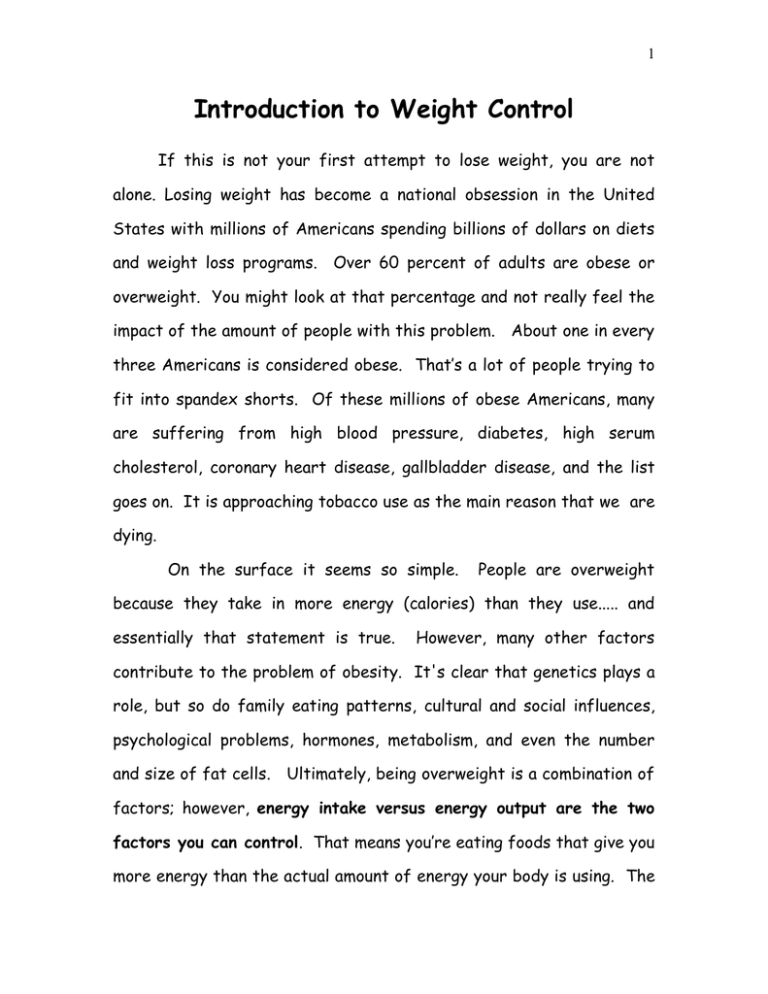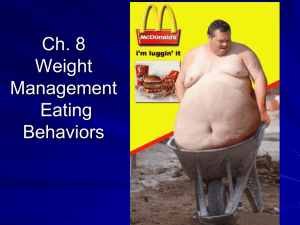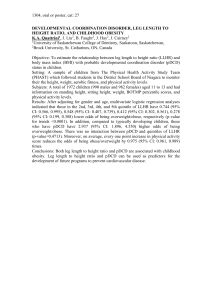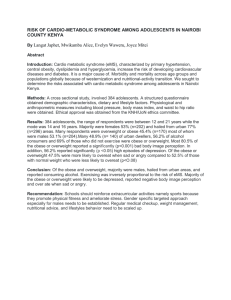Introduction to Weight Control
advertisement

1 Introduction to Weight Control If this is not your first attempt to lose weight, you are not alone. Losing weight has become a national obsession in the United States with millions of Americans spending billions of dollars on diets and weight loss programs. Over 60 percent of adults are obese or overweight. You might look at that percentage and not really feel the impact of the amount of people with this problem. About one in every three Americans is considered obese. That’s a lot of people trying to fit into spandex shorts. Of these millions of obese Americans, many are suffering from high blood pressure, diabetes, high serum cholesterol, coronary heart disease, gallbladder disease, and the list goes on. It is approaching tobacco use as the main reason that we are dying. On the surface it seems so simple. People are overweight because they take in more energy (calories) than they use..... and essentially that statement is true. However, many other factors contribute to the problem of obesity. It's clear that genetics plays a role, but so do family eating patterns, cultural and social influences, psychological problems, hormones, metabolism, and even the number and size of fat cells. Ultimately, being overweight is a combination of factors; however, energy intake versus energy output are the two factors you can control. That means you’re eating foods that give you more energy than the actual amount of energy your body is using. The 2 first thing you need to do is Stop it! And that is the point of this book, to help do that, to help eat better and exercise more and to control the eating related behaviors that are contributing to the weight problem. Overweight individuals experience difficulties with more than just body function and health. Even more noticeable in day-to-day life are the social/psychological consequences of being overweight. In our society a thin body is highly valued and over emphasized..... while an overweight person is often perceived as less attractive, capable, or successful. The constant prejudices that most overweight individuals experience can lead to a poor self-image, less confidence, a sense of isolation, anxiety, and depression. Although this does not happen all the time, it happens frequently enough to pressure most overweight people to try lose the extra weight. Ideally, society should change its attitude toward overweight individuals, however, that's probably not going to happen any time soon. Obesity is not only a problem with adults but it is also a big problem with children and adolescents. Of course the contributors are high fat foods and sedentary lifestyles. big Kids are watching about five hours of television each day and spending more time playing sedentary games instead of getting physical activity during the day. About half of the overweight or obese children grow up to be overweight/obese adults. 3 Many different ways to actually lose this extra weight have been identified. Treatment for weight loss has included surgical intervention, drugs, gimmicks, fasting, low calorie drinks, and of course thousands of diets and programs. The sheer numbers and diversity of the methods indicate our willingness to try almost anything to be thinner. And of course there are a lot of people that have tried lots of the different methods/diets and are still struggling with their weight. A major flaw in most of these techniques is maintaining the weight loss. Only programs that encourage permanent changes in eating and physical active that allow for weight maintenance have a chance for long-term success. This is such a simple concept, if it were just that easy. Adults, teenagers, and even children can follow recommendations for an appropriate weight loss program. All that is being asked is that you eat better and get more physical activity. 1. Learning to Eat Well This means having meals that give you energy, give your body the nutrients it needs, and leaves you feeling satisfied. It also means eating foods you like, fitting them into your lifestyle, and getting the results of losing weight and keeping it off that you want. 4 2. Increasing Physical Activity You need to do aerobic exercise to burn body fat. In addition, you need to do strength training to increase muscle density and metabolism to keep the fat from coming back. 3. Identify and Change Eating Habits that Are a Problem Habits are just learned behavior. And learned behavior can be unlearned or replaced with new better behaviors. Realize that you probably don't really want to change your current habits, but if you keep eating and exercising the same way, your weight will also stay the same.



